Executive Summary: The Science of Habits, Learning & Forgetting
“Excellence is an art won by training and habituation. We do not act rightly because we have virtue or excellence, but we rather have those because we have acted rightly. We are what we repeatedly do. Excellence, then, is not an act but a habit.” ~ Aristotle
The Effect of The Time Prism on Inculcating New Skills into Our Performance…
The core belief that drives all TQ Products — especially The Time Prism — is that you “BECOME what you LEARN”. Learn positive new ideas and employ them, you will become the best version of yourself possible.
The same is also true of the negatives. Learn bad habits that don’t serve you well, you will drift further away from the success you desire. Fail to learn how to overcome performance negatives such as unfocused, scattered, vague, pessimistic, fearful, doubtful, drained, etc. and your performance suffers… leading to failed hopes and dreams. But learn to become more optimistic, self-confident, engaged, focused, energetic, etc. and you will achieve more and get ahead faster.
With tens of millions of data points at TQ, we know this to be true, indeed measurable. More positives and fewer negatives in your performance drive a life of excellence… happiness… and meaning. (You may take your TQ Test anytime at ThinkTQ.com/Actual.)

Go to Your App Store and Search For: TIMEPRISM
Or simply click here…
 |
The fastest and easiest way to learn, remember and master success-critical skills for high achievement.
The Science…
Over the years there have been countless scientific studies on the process of learning something new, acting on it, and retaining this information for continuous on-going use. Science has now shown that the power of habit over our lives can be destructive, instructive, or a positive influence driving enduring success—personally and professionally.
We have strategically incorporated the current thinking on the science of effective behavior modification in the short review below. Add to this the accumulated research over the years at TQ — connecting high achievement with continuous personal growth — and the picture becomes clear: We can THRIVE, not merely SURVIVE when we have tools that inform smarter decisions in the moment.
The Time Prism is such a tool. It is now available for download.
Please share this link with all your friends, co-workers, family, etc. as it will help them become the best version of themselves possible. Your kindness will be greatly appreciated.
Flow… Tiny Habits… The Power of Habit… Hardwiring Happiness…
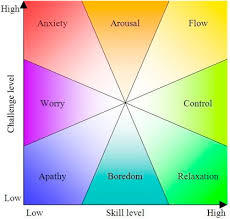 Years ago, University of Chicago scientist and psychologist Mihaly Csíkszentmihályi wrote about the process of flow in his book Flow: The Psychology of Optimal Experience. The idea is simple: The bigger the challenges we face, the stronger the skills we need to find enduring happiness.
Years ago, University of Chicago scientist and psychologist Mihaly Csíkszentmihályi wrote about the process of flow in his book Flow: The Psychology of Optimal Experience. The idea is simple: The bigger the challenges we face, the stronger the skills we need to find enduring happiness.
In Mihaly’s opinion, skill-building with the expectation of achievement is everything… it is the cause of happiness.
Big challenges with low skills lead to anxiety, worry, and fear (not happiness). Low-level challenges with high skills lead to apathy and boredom (not happiness).
Only when our skills match our challenges will we be in the “flow” where we are completely at one with our work, our lives, and relationships.
The optimal experience is what we all crave: Happiness — control over things that control us, and the opportunity to climb the Maslow hierarchy of needs to the point of true actualization… or most recently, transcendence. (Maslow amended his model, placing self-transcendence (realizing your full potential) as a motivational step beyond self-actualization.)
Our habits play a tremendous role in this…
 The recent work of neuroscientists at Stanford, Berkley, Harvard, etc. all point to the power and effect of positive habits on behavior and performance. For example, Dr. B. J. Fogg (Tiny Habits) connected the effect of computers on human behavior. He dubbed the science, Captology: Insights into how computing products — from websites to mobile phone software — can be designed to change what people believe and what they do.
The recent work of neuroscientists at Stanford, Berkley, Harvard, etc. all point to the power and effect of positive habits on behavior and performance. For example, Dr. B. J. Fogg (Tiny Habits) connected the effect of computers on human behavior. He dubbed the science, Captology: Insights into how computing products — from websites to mobile phone software — can be designed to change what people believe and what they do.
In fact, Dr. Fogg performed extensive research in the relationship between machines and human interactions regarding emotional motivators such as FLATTERY. There appears to be no difference if flattery comes from a human or your Smartphone! The recipient always feels better for being flattered.
In The Power of Habit, Pulitzer Prize-winning business reporter Charles Duhigg takes us to the thrilling edge of scientific discoveries that explain why habits exist and how they can be changed. Distilling vast amounts of information into engrossing narratives that take us from the boardrooms of Procter & Gamble to sidelines of the NFL to the front lines of the civil rights movement, Duhigg presents a whole new understanding of human nature and its potential.
Dr. Rick Hanson identified the link that unifies habit and positive thinking over Negativity Bias in his landmark book, Hardwiring Happiness: The New Brain Science of Contentment, Calm, and Confidence shows you how to tap the hidden power of everyday experiences to change your brain and your life for the better.
Dr. Hanson concluded it takes 3-5 Positives to overcome a single Negative because our brains are not hardwired for success or happiness. Over the millennia, our brains have been wired for survival… to keep us from harm or death.
In fact, as he so brilliantly deduces, our brains actually work against us — amplifying perceived risks… reducing perceived benefits… and worse, causing us to overestimate the costs versus benefits of change.
Thus, until we change the number of positive messages our brains receive each day, we remain stuck in survival-mode thinking, forsaking potential success and happiness.
The consensus is that we are the habits we make.
The Time Prism operates on the power of habit in much the same way Pavlov’s Dog Theory observes that it is the anticipation of a reward that controls our actions. A simple example of this is found in the Time Prism screenshot above — of which we have over 10,000 10-second sequences that are highly condensed and distilled ideas for action in a fast, easy to read format.
You hear the Tick Tock Tick from your Smartphone/iPad’s notification manager (the trigger) >> you read the message (the action) >> and you are rewarded with useful information that is instantly “doable” and produces immediately better results.
You either DO what it says in the moment or TUCK away the idea in your subconscious for later use. In this case, you see the immediate benefit (reward) of reaching clarity with whomever you are addressing. Reach mutual understanding and you are seen positively as “articulate, empathetic and attentive”. Fail to do this and you may be seen negatively as “vague, hazy and imprecise”.
The Time Prism shapes your thinking — informing smarter decisions in the moment leading to greater results over time.
When you build this habit, you become more powerful, simply because you have a greater number of positives and fewer negatives driving your performance. Thus, the habit of responding to the trigger >> taking the action >> and receiving the reward becomes the self-fulfilling prophecy of success.
It is also the genesis of our Transparent Learning Engine™: Learning without your even realizing you are learning!
Forgetting to Remember…
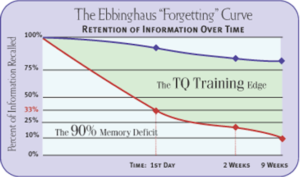
Ebbinghaus (a founder of what has now become modern psychology) proved that the rate at which we learn and remember is a curve influenced by the relevance of the information to us, and how frequently we review it. (We forget 66% of what we learn in just one day without review!)
His work is the basis for the concept of Spaced Repetition, and how it impacts our ability to remember what we have learned over time.
Simply, if we learn it, do not apply it, nor actively reinforce it, we FORGET it. Out of sight becomes out of mind—literally.
Forgetting is not influenced by intelligence, per se.
Forgetting is a function of a failure to remember due to lack of relevance, repetition, and reinforcement. If we fail to remember to take smarter actions in the moment, we are stuck with the limited actions we do take… which may or may not benefit us.
Fixing this problem is why we created The Time Prism: To take the best ideas, from the best brains who ever lived, and put them in front of you to shape your thinking in the moment.
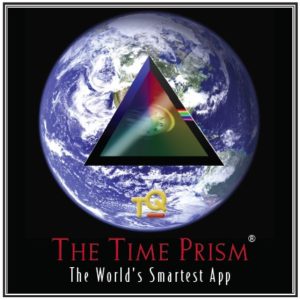
The Time Prism was developed to inform smarter decisions in the moment creating greater results over time…
The effective presentation of information that leads to new habits and skills is why we are transforming the world’s 2.5 Billion Smartphones into a Transparent Learning Engine™.
We engineered The Time Prism to help people remember the skills they already have—so they can employ them faster—and teach people new skills… releasing their full potential through smarter decisions in the moment.
Making people smarter about what they do in the moment is the challenge. The TQ Time Prism is the tool that makes this possible. We call reducing this 90% “memory deficit” the TQ Training Edge.
Providing new ideas all day long gives people the chance to grab one good idea and act on what it suggests. (If you don’t have new ideas, nothing changes.)
By reinforcing these “ideas on a theme” with spaced repetition, we implant the idea into the memory presenting it 8 different ways—in 10-second intervals—over the course of the day. The ideas are always relevant and you can immediately put them to use.
Awareness, perspective, and encouragement are the key.
The Encouragement to Act Smarter…
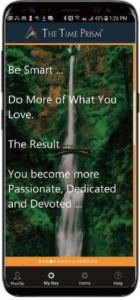 A perfect example of this is found in giant words such as APPRECIATION, GRATITUDE, THANKFULNESS, etc. As people, we tend to get caught up in our own drama and forget to be grateful and appreciative.
A perfect example of this is found in giant words such as APPRECIATION, GRATITUDE, THANKFULNESS, etc. As people, we tend to get caught up in our own drama and forget to be grateful and appreciative.
The heat of the battle causes us to forget the big picture and to stop for a moment to reflect. But, when encouragement is built into our day, we not only remember, but respond accordingly.
To re-state Aristotle, “You are not grateful because you say you are, but you are thankful because you show your gratitude by what you do. Gratitude then is not an act—it is a habit!”
Becoming smarter in the moment is not a buzz-phrase. It is what we do every time we pick up the Time Prism, read the key idea, take a breath and absorb it.
There is no question that the source of all progress in the world, personally, in business and professionally, is based on our performance over time. With hundreds of millions of data points at TQ, there is an undisputed connection between our actions and our results.
But, Until Now…
There has been no practical way to effect change in the moment.
Let’s say you want to make more money this year.
Build your business… more sales… a bigger paycheck… advance your career… bring out the best in your team… whatever.
The only way this will happen is if you learn to work smarter in the moment, making smarter decisions about a whole range of issues: Your attitude… personal energy level… sense of purpose and direction… and your ability to set clear goals for the day, week, month and year… and to make plans to support those goals… and to remain focused on the important… and to delegate more and build stronger teams… and to get and stay organized… and to master the clock… and continuously take smart ACTION.
It is the combination of ALL these performance drivers that yield the Results you want over Time: More Money.
The Time Prism is a tool for continuous personal change.
It inspires tiny habit changes — in the moment.
It encourages you to overcome Negativity Bias — in the moment.
It keeps you in the Flow — in the moment.
It is the tool of anticipatory rewards — in the moment.
It is the cure to the Ebbinghaus Forgetting Curve — in the moment.
Finally, it is the key to self-actualization and transcendence — where you achieve up to your full potential — in the moment.
Conclusion…
The science is clear: We are the sum of our habits, the information we absorb leading to the decisions we make and the actions we take on a daily basis.
If you want to be happy, get into the Flow where your Skills surpass your Challenges.
If the objective is to move beyond Negativity Bias, survival-mode thinking to a high level of confidence, self-esteem, respect, and accomplishment — to rise to self-actualization — we must engage in the daily pursuit of excellence.
As Aristotle so rightly observed, excellence is the result of smarter actions taken consistently. It is not an act, it is a habit.
Behavioral scientists agree that a higher level of performance is possible when we modify our thoughts, beliefs, and actions… to make excellence our prevailing aspiration.
Smarter actions in the moment yield greater results.
Greater results in the moment lead to a better life.
It all starts with smarter ideas, applied in the moment… which is WHY we created the world’s first Time Prism: The World’s Smartest App™.
Inform smarter decisions in the moment, you achieve up to your full potential.
And if you live up to the best that is within you, what more is there?
That’s right. Nothing!
er
P.S. To refresh your memory of Maslow’s Hierarchy, we have included it here with the Time Prism applied. Ultimately, Maslow added an additional level: TRANSCENDENCE… our ability to give back to the world. Pretty much what The World Excellence Project is all about!
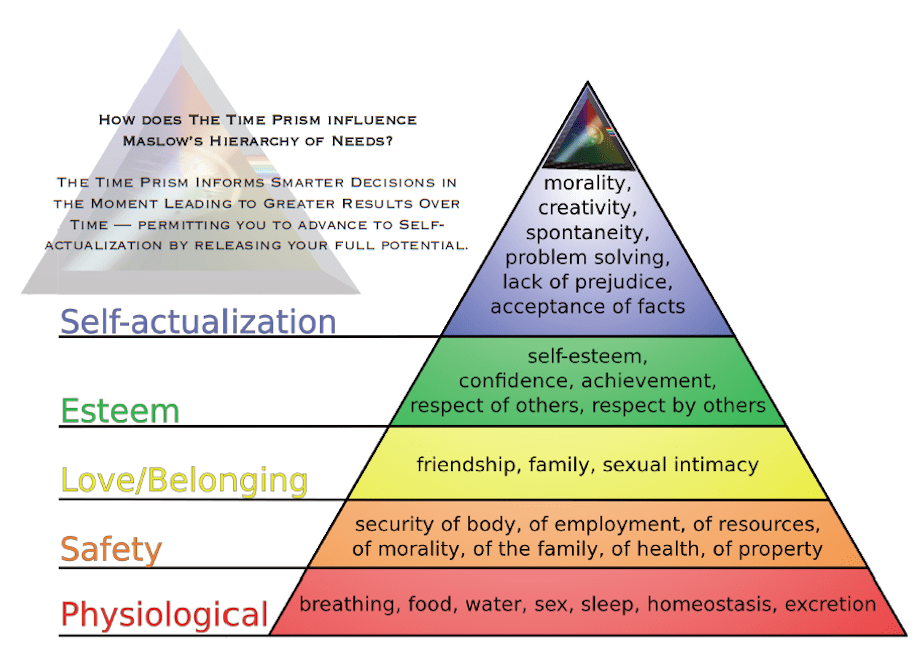
“Winning is not a sometime thing; it’s an all the time thing. You don’t win once in a while… you don’t do things right once in a while… you do them right all the time. Winning is a habit.” ~ Vince Lombardi
|

